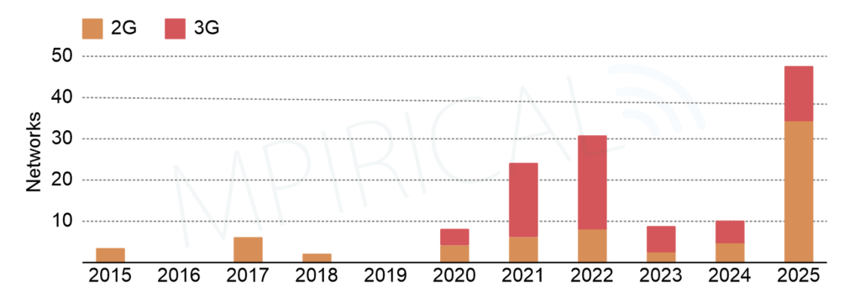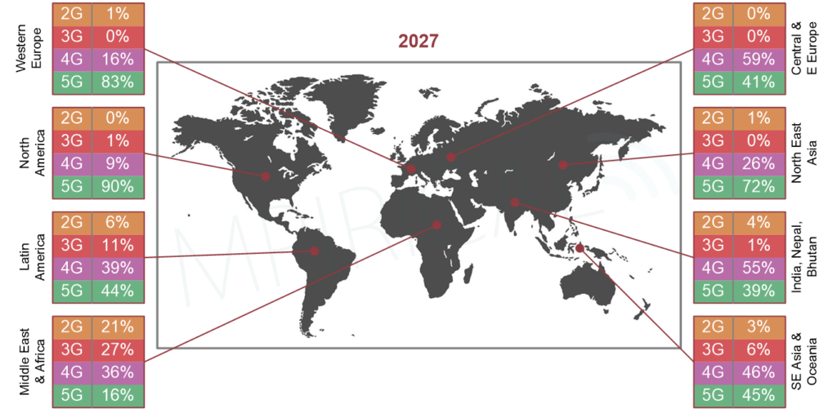
2G and 3G Drawdown
With more and more service providers finally switching on their 5G standalone networks, not to mention the increasing chatter and speculation as to what 6G will actually be, it is easy to forget that in many countries 2G and 3G networks are still operating. That is, unless you are one of those people who still have the misfortune to live in a “not spot”, an area still lacking a decent 4G or 5G signal!
2G (GSM & GPRS) and 3G (UMTS) networks are however beginning to disappear as mobile service providers re-farm valuable radio spectrum to the more efficient 4G and 5G networks and retire end of life network infrastructure. In fact, according to the GSA, the Global Mobile Suppliers Association, in some countries 2G networks were switched off as early as 2015, whereas 3G switch off began in 2020. What’s interesting is that with the exception of 2025, 3G switch off is expected to outpace 2G from 2021 onwards.

Reviewing these figures in a little more detail, we can see that the rate of switch off will not be common across all regions. According to Ericsson, by 2027 2G will have been switched off in its entirety in both North America and Central & Eastern Europe, whereas 3G will have disappeared in Western Europe and North East Asia. However, in the Middle East & Africa, 2G is still expected to represent 21% of the total mobile subscriptions whilst 3G equates to 27%.

 One of the main reasons why 2G and 3G will continue to operate in some regions comes down to the cost of the mobile phones or devices. GSM, GPRS and UMTS enabled devices are considerably cheaper to produce than the more sophisticated smartphones associated with 4G and 5G. Taking a cursory search of the Internet, it is possible to purchase 2G radio modules, a key component in a mobile phone, for less than $1 per unit. This compares to $34 per unit for a 4G radio module and $120 for one which can support 5G. As such, the $1,000 5G smartphone may be commercially viable in some regions of the world, but there are many countries where this would represent significantly more than the average monthly income. As such, mobile service providers need to consider not only the cost of upgrading their network infrastructure but also whether their subscriber base can afford the latest technology. Furthermore, mobile phones which have been traded in against a new phone in some countries will often find a second life in a different country.
One of the main reasons why 2G and 3G will continue to operate in some regions comes down to the cost of the mobile phones or devices. GSM, GPRS and UMTS enabled devices are considerably cheaper to produce than the more sophisticated smartphones associated with 4G and 5G. Taking a cursory search of the Internet, it is possible to purchase 2G radio modules, a key component in a mobile phone, for less than $1 per unit. This compares to $34 per unit for a 4G radio module and $120 for one which can support 5G. As such, the $1,000 5G smartphone may be commercially viable in some regions of the world, but there are many countries where this would represent significantly more than the average monthly income. As such, mobile service providers need to consider not only the cost of upgrading their network infrastructure but also whether their subscriber base can afford the latest technology. Furthermore, mobile phones which have been traded in against a new phone in some countries will often find a second life in a different country.
That said, the question that still arises is why in Western Europe, North America and North East Asia, where 5G take up is expected to reach circa 80%+, do we still see 2G and 3G networks operating, albeit at very low percentages? Well, in these regions we may well see other factors at play.
Telemetry and Machine Type Communications
 When we consider packet switched data on both 2G and 3G networks, we often just assume that we are talking about mobile phones and subscribers downloading emails and accessing web pages on the Internet. However, that would be wrong because these networks have for some time also been supporting telemetry or machine type communications. For example, smart meters recording the amount of electricity, gas, or water a consumer has used typically use this legacy technology to connect back into the utility company’s networks. Likewise, eCall, a pan European system has required all cars since 2018 to be fitted with an emergency calling system which activates should the car have been involved in an accident. These are also typically utilizing 2G and 3G radio modules so should the networks be turned off, the system would fail. In many of these cases, the mobile service providers have signed extended contracts to support connectivity so they must either bear the cost of upgrading all the devices to 4G or 5G or, as is happening, continue to maintain the networks into the future. That said, these networks will be carrying very limited traffic so they can certainly be scaled back, enabling resources such as radio frequency bands to be moved to 4G and 5G.
When we consider packet switched data on both 2G and 3G networks, we often just assume that we are talking about mobile phones and subscribers downloading emails and accessing web pages on the Internet. However, that would be wrong because these networks have for some time also been supporting telemetry or machine type communications. For example, smart meters recording the amount of electricity, gas, or water a consumer has used typically use this legacy technology to connect back into the utility company’s networks. Likewise, eCall, a pan European system has required all cars since 2018 to be fitted with an emergency calling system which activates should the car have been involved in an accident. These are also typically utilizing 2G and 3G radio modules so should the networks be turned off, the system would fail. In many of these cases, the mobile service providers have signed extended contracts to support connectivity so they must either bear the cost of upgrading all the devices to 4G or 5G or, as is happening, continue to maintain the networks into the future. That said, these networks will be carrying very limited traffic so they can certainly be scaled back, enabling resources such as radio frequency bands to be moved to 4G and 5G.
Elderly Subscribers
 Finally, we should also consider that although we work in the industry and perhaps find technology interesting, not everyone is as fascinated with the latest equipment and accessing the hottest applications. For example, for many elderly subscribers, all they require from a mobile device is to simply make calls and perhaps send a text message or two. To some, a fully featured smartphone may be a step too far, as they need to set up accounts with app stores and configure the phone to send and receive emails. As such, they may perhaps rather just stay with their old, but functional, 2G phone.
Finally, we should also consider that although we work in the industry and perhaps find technology interesting, not everyone is as fascinated with the latest equipment and accessing the hottest applications. For example, for many elderly subscribers, all they require from a mobile device is to simply make calls and perhaps send a text message or two. To some, a fully featured smartphone may be a step too far, as they need to set up accounts with app stores and configure the phone to send and receive emails. As such, they may perhaps rather just stay with their old, but functional, 2G phone.
Granted, following the COVID-19 pandemic, life has quickly moved on to a digital future, with it becoming increasingly difficult to deal with day-to-day tasks without a smartphone however, for some, the jump is still too great.
Therefore, what should the mobile service provider do? Well, basically they have three options: they could swap out everyone’s 2G / 3G phone for a new and simplified 4G phone, they could just turn off the network and suffer the consequences, or finally they could continue to maintain the networks as they are needed to support some telemetry applications and wait until this subscriber base moves on!
